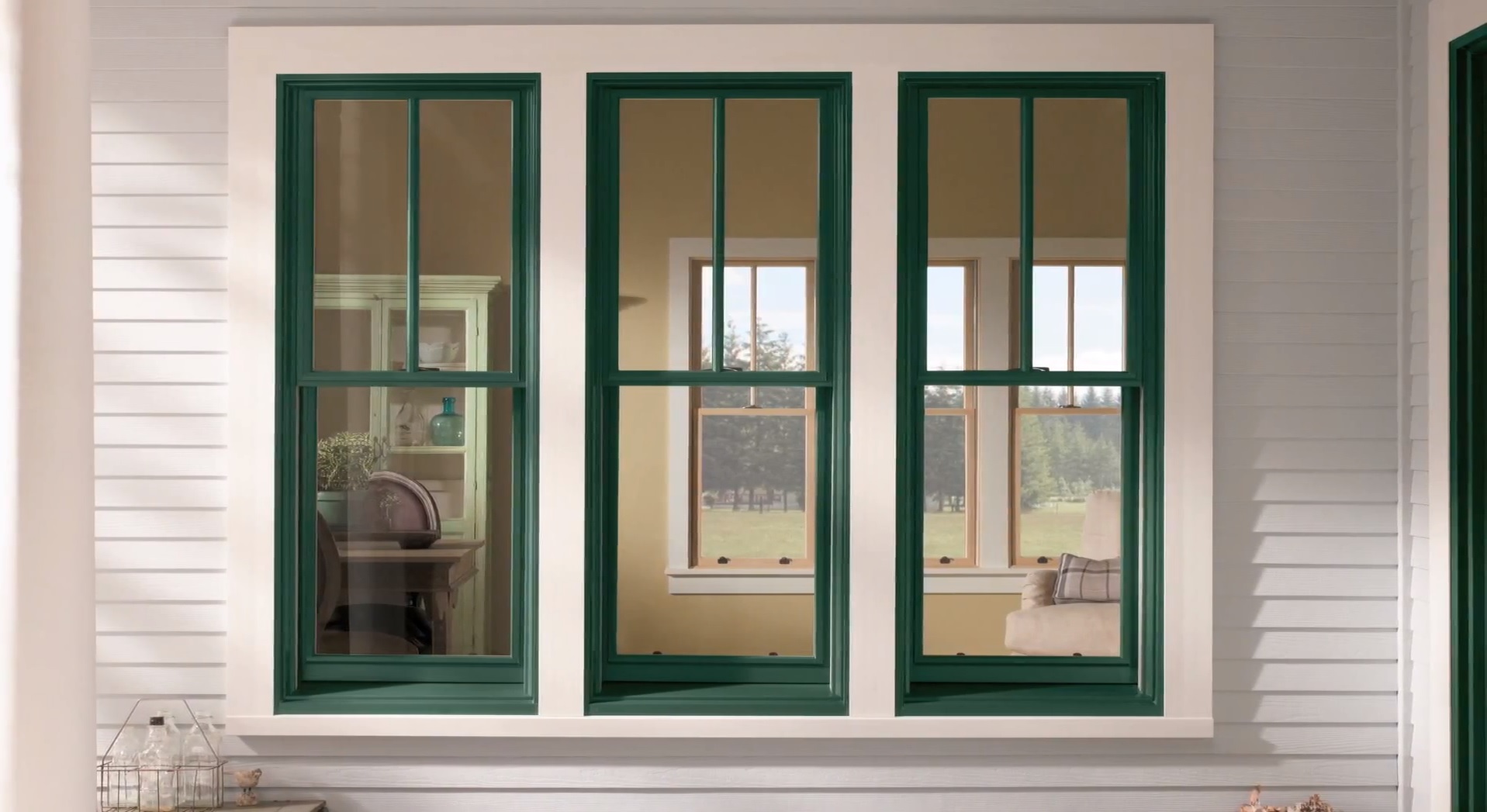Submitted by Energy Efficiency First
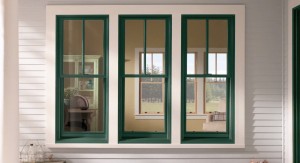 Windows provide our homes with light, warmth, and fresh air. But because windows are thermal holes, they can also reduce a home’s energy efficiency. To reduce energy costs and to help keep the home’s temperature consistently comfortable, many people opt to replace old drafty windows with new energy-efficient windows.
Windows provide our homes with light, warmth, and fresh air. But because windows are thermal holes, they can also reduce a home’s energy efficiency. To reduce energy costs and to help keep the home’s temperature consistently comfortable, many people opt to replace old drafty windows with new energy-efficient windows.
The cost effectiveness of replacing windows depends on the condition of your home and your existing windows.
If you notice an issue that will decrease your home’s durability, like water damage, it is paramount that you track down and address the root cause and repair the damage. When this scenario involves a window, the rotted window may be the symptom, not the source, of the leak. Find and stop the source of the leak, then replace the window and rotten framing. A complete window replacement is best because it allows you to integrate the new window fully into the wall with new water-shedding flashing, air-sealing foam, and high-quality water sealants.
If your home’s existing windows are old, leaky or damaged, installing replacement windows will generally pay for itself, in the form of lower energy bills, within 2 to 10 years. EnergyStar.gov estimates that you will save from 7 to 24 percent on energy costs if you install Energy Star qualified windows; the percentage will be on the high end if you are replacing old single-paned windows. In the same vein, the U.S. Department of Energy estimates that a typical homeowner in the Northwest will save $258 a year when replacing single-pane windows and $112 a year when replacing double-pane, clear glass windows with double pane, argon filled, low-e coated windows that are Energy Star qualified.
Two years ago one of our clients wrote us a letter thanking us for professionally installing insulation and replacement windows in her home, citing her energy bills dropped by half and she felt more comfortable.
When it comes to installing replacement high-efficiency windows, both the federal government and your local utility are on your side. In homes heating with electric, Puget Sound Energy offers a rebate of up to $1,500 for replacement windows. Congress offers a $200 tax credit that can go up to $500 if replacement doors are involved.
SELECTING REPLACEMENT WINDOWS
It’s important to realize that when you remove a window from a wall, you’re left with a large hole in your house. You should plug that hole with something that will perform well, last long, and look good.
Choose Based on Energy Performance Expectations
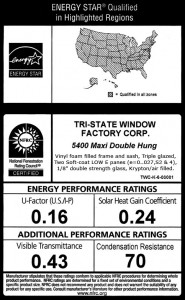 When it comes to energy efficiency, you can’t trust your eyes alone. Two windows that look exactly alike can perform very differently. The invisible parts of a window combine to boost performance, energy efficiency, and comfort. Different glass coatings, gas fillings, and spacers between glass panels are impossible to differentiate visually. They can be verified only through laboratory tests and the associated ratings that come from the U.S. Department of Energy’s Energy Star Program and from the National Fenestration Rating Council (NFRC). Any window worth using boasts a sticker revealing its Energy Star and NRFC rating.
When it comes to energy efficiency, you can’t trust your eyes alone. Two windows that look exactly alike can perform very differently. The invisible parts of a window combine to boost performance, energy efficiency, and comfort. Different glass coatings, gas fillings, and spacers between glass panels are impossible to differentiate visually. They can be verified only through laboratory tests and the associated ratings that come from the U.S. Department of Energy’s Energy Star Program and from the National Fenestration Rating Council (NFRC). Any window worth using boasts a sticker revealing its Energy Star and NRFC rating.
The two most important factors considered by Energy Star and the NFRC are:
- U-factor: This value expresses the window’s heat loss rate. It is based on the energy performance of all the window’s component parts, operating as a whole (the number of panes of glass, the thickness of each glass pane, the coatings on the glass, the gas in between the glass, and the material from which the sash and frame are made). Smaller numbers (0.35 or less) mean greater energy efficiency and comfort. The lower the U-factor, the better. In the Northwest, windows must have a U-factor of 0.3 or lower to receive the Puget Sound Energy rebate and the federal tax credit.
- Solar heat-gain coefficient (SHGC): Percentage of the sun’s radiant heat getting into your house. In colder climates, like the Northwest, a higher SHGC is okay, even good. In the Northwest, windows may have an SHGC rating as high as .4 and still receive the federal tax credit. Windows in Florida, by comparison, can get the tax credit with an SHGC rating of .27 or below.
The following “invisible” window characteristics affect U-factor and SHGC:
Gas filling: Like air, argon is nontoxic, clear, and odorless, but it’s a better insulator. The optimal gap between panes of glass is 1⁄2 in.
Low-emittance (low-e) coatings: These are nearly transparent metal films. All low-e coatings bounce radiant heat back into the home in the winter. Most reflect the sun’s radiant heat in summer, too.
Double-glazing: A “glazing” is one layer of glass. The more glazes, the higher the U-factor. Two layers of glass (double glazing) are standard. Triple-glazing is a good idea in very cold areas. Sometimes the different layers of glass will have different tints or coatings on them to affect the rate of light verses solar heat (SHGC) that can get into the home through the window.
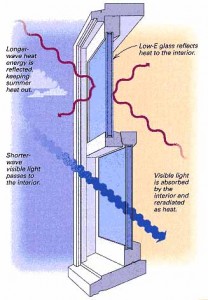 Warm-edge spacers: Specialized rubbers, foams, and plastics that improve U-factor and reduce condensation or thermal bridging through the glass itself.
Warm-edge spacers: Specialized rubbers, foams, and plastics that improve U-factor and reduce condensation or thermal bridging through the glass itself.
Choosing Based on Framing Material
Choosing window framing material is an important part of window selection. The material from which a window frame is made greatly affects its energy performance. Framing material and construction also affect durability, maintenance, aesthetics, and cost.
From an energy-efficiency perspective, the frame material should be as thermally non-conductive as possible. A rate of thermal conductivity is a measurement of how quickly heat travels through an object from an area of a higher temperature to an area of a lower temperature. Materials that have very tightly bound molecules allow faster heat conduction. Wood, vinyl, and fiberglass provide greater thermal resistance than metal, which is very dense and conducts heat quickly.
A few interesting facts about wood, aluminum, walls, and relativity:
Green construction companies like ours know, when it comes to wall construction, wood is considered to be very thermally conductive – its acts as a “thermal bridge.” To stop wood wall studs from conducting heat to the outside, modern wall-construction methods place a layer of thermally non-conductive material on the outside, such as foam insulation board. This acts as a thermal break, keeping more heat in the wall. Yet, in the world of windows, wood window frames rank highly on the list of recommended framing material with the U.S. Department of Energy calling wood a “good insulator.” This just goes to show that relativity is a key concept when it comes to window framing material and energy efficiency; how thermally conductive is the frame compared with other available frames.
While wood, in the world of windows, is considered a good insulator, metal is such a great heat conductor that, in colder climates, metal frame windows have been phased out. Not easy to give up, aluminum window manufactures now make aluminum windows with a thermal break sandwiched in the middle, and these are still sold in warmer climates. We haven’t yet seen a wood window manufactured with a thermal break sandwiched in the middle, yet. Perhaps this will come in the next generation. Vinyl and fiberglass window manufacturers, however, have begun filling their window frames with foam insulation.
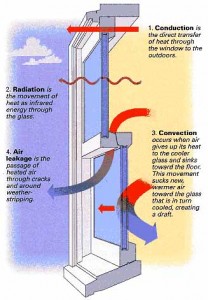 Perhaps someday windows will approach the R-values of today’s walls. Even the most energy efficient window we could find in today’s marketplace, however, which has a U-factor of .16, is only one-third as efficient as a standard wall. A U-factor of .16 translates into an R-value of 6.25. By comparison, the Washington building code requires that walls be constructed to R-19. Eventually, the marketplace might support, or regulations might require, the commonplace manufacture of windows containing a thermal brake, insulation, and perhaps 4-5 layers of glazing filled with krypton gas. Until then, we recommend that consumers strive to purchase the most energy efficient window frame available and within budget.
Perhaps someday windows will approach the R-values of today’s walls. Even the most energy efficient window we could find in today’s marketplace, however, which has a U-factor of .16, is only one-third as efficient as a standard wall. A U-factor of .16 translates into an R-value of 6.25. By comparison, the Washington building code requires that walls be constructed to R-19. Eventually, the marketplace might support, or regulations might require, the commonplace manufacture of windows containing a thermal brake, insulation, and perhaps 4-5 layers of glazing filled with krypton gas. Until then, we recommend that consumers strive to purchase the most energy efficient window frame available and within budget.
Official guidance on window frame material:
The U.S. Department of Energy, the National Fenestration Rating Council, and other experts, such as Fine Home Building Magazine, provide the following guidance about the energy efficiency, durability, and affordability of the window frame materials commonly available in the Northwest market. This guidance, and the stated U-factors, is for the window frames only without relation to the insulated glass units that fit inside.
Wood Frames: Wood window frames insulate relatively well with a typical U-factor of 0.5. But they also expand and contract in response to weather. Wood frames also require regular maintenance, such as paint. When well-maintained, wood windows should last a long time. Aluminum or vinyl cladding of the wood window reduces maintenance requirements, but adds expense. Even without the cladding, wood windows are more expensive than vinyl. Wood windows are typically less expensive than fiberglass.
Fiberglass Frames: Fiberglass window frames are dimensionally stable and are stronger than vinyl. There are no maintenance requirements, although fiberglass can be painted. The hollow cavities of fiberglass frames can be filled with insulation. Un-insulated fiberglass frames typically have a U-factor of 0.5. When insulated, the U-factor of fiberglass frames decreases to 0.33, which makes them thermally superior to standard wood frames. The relative cost of fiberglass is more expensive than a standard wood window and more expensive than vinyl.
Vinyl Frames: Vinyl window frames are usually made of polyvinyl chloride (PVC) with ultraviolet light (UV) stabilizers to keep sunlight from breaking down the material. Vinyl window frames do not require painting and have good moisture resistance. The hollow cavities of vinyl frames can be filled with insulation. Un-insulated vinyl frames typically have a U-factor of 0.5. When insulated, the U-factor of vinyl frames decreases to 0.33, which makes them thermally superior to standard wood frames and provides the same performance as fiberglass frames. Vinyl windows are almost always less expensive than wood and fiberglass.
Some environmental groups argue that vinyl is too toxic to be considered green, even though an insulated vinyl window has a lower U-factor than a wood frame. Vinyl is very stable, so there’s really not any human health risk to the homeowner. The concern is that the chemicals used to make vinyl windows can be harmful during the manufacturing process and at the end of its use upon disposal. This is weighed by many against the benefit of more and more homeowners being able to afford a durable window that enhances the thermal performance and energy efficiency of their home.
Most of our window clients opt for vinyl framed, double pane, argon gas, and low-e coated windows. They look good, last a long time, are maintenance free, and they are affordable, even when selecting the upper level, higher quality and foam insulated windows.
Choosing Based on Manufacturer and Warranty
There are bad windows made from wood, vinyl, and fiberglass, just as there are good windows made from each of these materials. You have to pay attention to the window construction and to the warranties offered by the manufacturer.
Whatever the window framing material, look for windows with the following characteristics: The connections where the frame joins together must be tightly sealed to keep out water and air. Weather stripping needs to seal tightly after hundreds of window closings, rain wettings, sun exposures, and winter freezes. Inexpensive and flimsy materials will not endure the test of time and weather. Compressible gaskets like those used to seal car doors are the best. Closures must be substantial enough to tightly clinch windows shut. Look carefully at these components and inquire about the window’s track record of performance.
It is also best to stick with windows that come with a good warranty. Warranties reflect a manufacturer’s confidence in its product’s durability. Good window companies offer a 20 year warranty on the window seal and 5-10 years on everything else (frame, sash, and hardware). Even if a window is rated well by the NRFC, if a window manufacturer offers a prorated warranty and it is full of exclusions, such as non-transferability, you have to question the window. Similarly, be wary of warranties that sound too good to be true and are more generous than what the mainline well-known companies can offer.
Buy Local and Find a Qualified Professional Window Installer
As a local company, we like to support other local businesses. As a company that professionally installs vinyl windows and vinyl sliding glass doors in Thurston County, we are fortunate to have a quality vinyl window manufacturer right here in Washington State. Everything about these products is local in that it comes from the Northwest. This includes the sand used to roll the glass, which is mined near Spokane. The glass is manufactured at a plant in Winlock. The insulated glass units (IGUs) are assembled in Hood River, Oregon. Finally, the IGUs are placed into custom made vinyl window frames in Spokane, Washington. The basic window is a well-built double glazed window with low-e coatings and a pillow of argon gas between the glazings. Options such as foam-filled insulated frames, triple glazing, enhanced-view screens, and special locking systems are available.
It is also important to have your windows installed by a reputable, experienced professional window installer. A poor installation practically will guarantee failure of even the most expensive, high-performance window. At Energy Efficiency First, in partnership with Quality Renovation and Carpentry, our owner is an energy auditor with over 25 years of residential remodeling experience, and our installer has installed windows professionally for over 30 years, as his sole profession. Now, his son installs windows with him.
If you’re in the market for replacement windows, call us for a free consultation and estimate.
CONSIDER IMPROVING THE ENERGY EFFICIENCY OF THE REST OF THE HOME FIRST
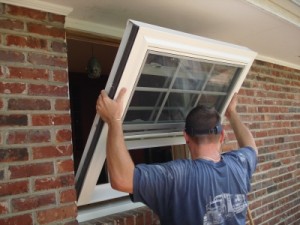 There may be several reasons that you would consider replacement windows. Perhaps you want to give your home a facelift and stop those annoying drafts that make you feel cold. Perhaps the home is experiencing durability issues and it makes sense to address replacement windows in the process of repairing the damage. If these are your reasons, go ahead and get your replacement windows now. If, however, energy and cost savings are the motivator, make windows the second stop on your road to success. Or said another way, pick the less expensive, low hanging fruit first:
There may be several reasons that you would consider replacement windows. Perhaps you want to give your home a facelift and stop those annoying drafts that make you feel cold. Perhaps the home is experiencing durability issues and it makes sense to address replacement windows in the process of repairing the damage. If these are your reasons, go ahead and get your replacement windows now. If, however, energy and cost savings are the motivator, make windows the second stop on your road to success. Or said another way, pick the less expensive, low hanging fruit first:
- Air seal the building envelope to stop wasteful air infiltration through HVAC, electrical, and plumbing penetrations, and more.
- In the attic, install as close to R-49 (loose fill) insulation as possible.
- Completely fill the joist bays in the floor with fiberglass batts that fit snugly to the under-floor.
- Insulate the walls, preferably with dense-packed blown cellulose that will provide air sealing benefits.
- Insulate and air seal the forced-air duct work the leaks air you paid to heat into the crawl space.
- Now you’re ready for energy-efficient replacement windows: There is no denying that a new double-pane or triple-pane window with argon gas and low-e coating will seriously outperform a single-pane window, especially one with an older aluminum frame.
CONSIDER IMPROVING THE ENERGY EFFICIENCY OF EXISTING WINDOWS
If your budget is tight of if you already have double pane windows, energy efficiency improvements to existing windows can also help: replacing only the window sash, adding storm windows, caulking and weather stripping, and using window treatments or coverings.
If the existing frame and sill are in good condition, you can swap the sash for an energy-efficient upgrade. The sash is the part that holds the glass and sits inside the stationary window frame. To replace the sash, remove it and the parting stops, then install jamb liners against the sides of the window frame. The liners form a tight seal with the new sash. Many manufacturers have replacement-sash kits designed for their older frames. A sash swap out is not recommended for homes in the Northwest with older aluminum frame windows.
Adding storm windows can reduce air leakage and improve comfort. Unfortunately, when we price storm windows for clients, we find that a storm window is often just as expensive as a replacement window. With modern window technologies and designs, replacement windows often are a better way to go.
Caulking and weather stripping can reduce air leakage or infiltration around windows. Use caulk for stationary cracks, gaps, or joints less than one-quarter-inch wide, and weather stripping for building components that move, such as doors and operable windows. Window treatments or coverings can reduce heat loss in the winter and heat gain in the summer. Most window treatments, however, aren’t effective at reducing air leakage.
If you’re in the market to make your home more energy efficient, durable, and healthy, call us today. We offer energy audits and building performance services to make your home or small business more energy efficient, comfortable, healthy, and durable. We provide you with a free consultation and estimate. To learn more, click here.









































